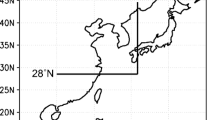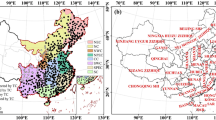Abstract
This study carried out a comparative analysis of the changes in tropical cyclone (TC) genesis, TC track, and TC intensity focusing on TCs that affected the Korean peninsula (KP) according to three evolutionary patterns (prolonged, abrupt and symmetric-decay) of the abnormal sea surface temperature in the Central-Pacific (CP) region. As a result of the analysis, the activity pattern of TCs was found to vary depending on the evolution patterns of the CP El Niño, and such changes appeared to result in clear variations in the regional rainfall in Korea. In the prolonged-decaying and symmetric-decaying years, the KP received considerable TC rainfall. On the other hand, in abrupt-decaying years, it was subtly affected by the TC rainfall. Although rather limited conditions and relatively short observation data were used to analyze the effects of the evolution pattern of the CP El Niño on TCs, the results can be used to quantitatively identify the spatial features of TCs affecting the KP. These results are expected to be helpful in managing the disaster risks in vulnerable areas, including plans to secure stable water resources in the basin, and in establishing effective and active measures to cope with natural disasters by extreme events over the KP.









Similar content being viewed by others
References
Ashok K, Behera SK, Rao SA, Weng H, Yamagata T (2007) El Niño Modoki and its possible teleconnection. J Geophys Res 112:C11007. doi:10.1029/2006JC003798
Becker RA, Chambers JM, Wilks AR (1988) The new S language: a programming environment for data analysis and graphics. Wadsworth & Brooks/Cole Advanced Books & Software, Monterey
Camargo SJ, Sobel AH (2005) Western North Pacific tropical cyclone intensity and ENSO. J Clim 18:2996–3006
Chan JCL (2000) Tropical cyclone activity over the western North Pacific associated with El Niño and La Niña events. J Clim 13:2960–2972
Chen G, Tam CY (2010) Different impacts of two kinds of Pacific Ocean warming on tropical cyclone frequency over the western North Pacific. Geophys Res Lett 37:L01803. doi:10.1029/2009GL041708
Chen TC, Wang SY, Yen MC (2006) Interannual variation of the tropical cyclone activity over the western North Pacific. J Clim 19:5709–5720
Emanuel K (2005) Increasing destructiveness of tropical cyclones over the past 30 years. Nature 436:686–688
Emanuel K, Sundararajan R, Williams J (2008) Hurricanes and global warming—results from downscling IPCC AR4 simulations. Bull Am Meteorol Soc 89:347–367
Feng J, Chen W, Tam CY, Zhou W (2011) Different impacts of El Niño and El Niño Modoki on China rainfall in the decaying phases. Int J Climatol 31:2091–2101
Gray WM (1979) Hurricanes: their formation, structure and likely role in the tropical circulation. In: Shaw DB (ed) Meteorology over the tropical oceans. Royal Meteorological Society, London, pp 155–218
Grimm AM (2011) Interannual climate variability in South America: impacts on seasonal precipitation, extreme events, and possible effects of climate change. Stoch Environ Res Risk Assess 25:537–554
JMA(Japan Meteorological Agency) (2012) www.jma.go.jp/jma/jma-eng/jma-center/rsmc-hp-pub-eg/trackarchives.html. Accessed 3 January 2013
Kao HY, Yu JY (2009) Contrasting eastern-Pacific and central-Pacific types of El Niño. J Clim 22:615–632. doi:10.1175/2008JCLI2309.1
Kim JS, Jain S (2011) Precipitation trends over the Korean peninsula: typhoon-induced changes and a typology for characterizing climate-related risk. Environ Res Lett 6:034033. doi:10.1088/1748-9326/6/3/034033
Kim JH, Ho CH, Lee MH, Jeong JH, Chen D (2006) Large increase in heavy rainfall associated with tropical cyclone landfalls in Korea after the late 1970s. Geophys Res Lett 33:L18706. doi:10.1029/2006GL027430
Kim TW, Yoo CS, Ahn JH (2008) Influence of climate variation on seasonal precipitation in the Colorado River Basin. Stoch Environ Res Risk Assess 22:411–420
Kim HM, Webster PJ, Curry JA (2011) Modulation of North Pacific tropical cyclone activity by three phases of ENSO. J Clim 24:1839–1849
Kim JS, Li RCY, Zhou W (2012a) Effects of the Pacific-Japan teleconnection pattern on tropical cyclone activity and extreme events over the Korean peninsula. J Geophys Res 117:D18109
Kim JS, Zhou W, Wang X, Jain S (2012b) El Niño Modoki and the summer precipitation variability over South Korea: a diagnostic study. J Meteorol Soc Jpn 90(5):673–684
Knuston TR, McBride JL, Chan J, Emanuel K, Holland G, Landsea C, Held I, Kossin JP, Srivastava AK, Sugi M (2010) Tropical cyclones and climate change. Nat Geosci 3:157–163
Kug JS, Jin FF, An SI (2009) Two types of El Niño events: cold tongue El Niño and warm pool El Niño. J Clim 22:1499–1515
Kwon HH, Lall U, Obeysekera J (2009) Simulation of daily rainfall scenarios with interannual and multidecadal climate cycles for South Florida. Stoch Environ Res Risk Assess 7:879–896
Larkin NK, Harrison DE (2005) On the definition of El Niño and associated seasonal average U.S. weather anomalies. Geophys Res Lett 32:L13705. doi:10.1029/2005GL022738
NOAA (national weather service climate prediction center) (2012) www.cpc.ncep.noaa.gov/data/indices/. Accessed August 2013
Nolan DS, Rappin ED, Emanuel KA (2007) Tropical cyclogenesis sensitivity to environmental parameters in radiative-convection equilibrium. Q J R Meteorol Soc 133:2085–2107
Oh TS, Moon YI (2009) An evaluation of extreme precipitation based on local downpour using empirical simulation technique. J Korean Soc Civ Eng KSCE 29(2B):141–153
Park JK, Kim BS, Jung WS, Kim EB, Lee DG (2006) Change in statistical characteristics of typhoon affecting the Korean peninsula. Atmosphere 16:1–17
Ripley BD (1987) Stochastic simulation. Wiley, New York
Schonher T, Nicholson SE (1989) The relationship between California rainfall and ENSO events. J Clim 2:1258–1269
TRC (Typhoon Research Center) (2012) http://www.typhoon.or.kr/. Accessed 12 February 2013
Wallace JM, Hobbs PV (2006) Atmospheric science, 2nd edn. Academic Press, New York. ISBN 978-0-12-732951-2
WAMIS (Water management information system) (2012) http://wamis.go.kr/eng/. Accessed 12 February 2013
Weng H, Behera SK, Yamagata T (2009) Anomalous winter climate conditions in the Pacific Rim during recent El Niño Modoki and El Niño events. Clim Dyn 32:663–674
Yoon SK, Kim JS, Lee JH, Moon YI (2013) Hydrometeorological variability in the Korean Han River Basin and its sub-watersheds during different El Niño phases. Stoch Environ Res Risk Assess 27:1465–1477
Yu JY, Kao HY (2007) Decadal changes of ENSO persistence barrier in SST and ocean heat content indices: 1958–2001. J Geophys Res 112:D13106. doi:10.1029/2006JD007654
Yu JY, Kim ST (2010) Three evolution patterns of Central-Pacific El Niño. Geophys Res Lett 37:L08706
Acknowledgments
This CRI work was supported by the National Research Foundation of Korea (NRF) grant funded by the Korea government (2012R1A1A2005304) and also funded by The Korea Meteorological Administration Research and Development Program under grant CATER 2012-3100 (Development of Drought Outlook. Response Techniques on Korea and East Asia). The authors thank the editor and the two anonymous reviewers for their constructive comments and valuable suggestions, which helped us to improve the manuscript.
Author information
Authors and Affiliations
Corresponding author
Rights and permissions
About this article
Cite this article
Son, CY., Kim, JS., Moon, YI. et al. Characteristics of tropical cyclone-induced precipitation over the Korean River basins according to three evolution patterns of the Central-Pacific El Niño. Stoch Environ Res Risk Assess 28, 1147–1156 (2014). https://doi.org/10.1007/s00477-013-0804-0
Published:
Issue Date:
DOI: https://doi.org/10.1007/s00477-013-0804-0




